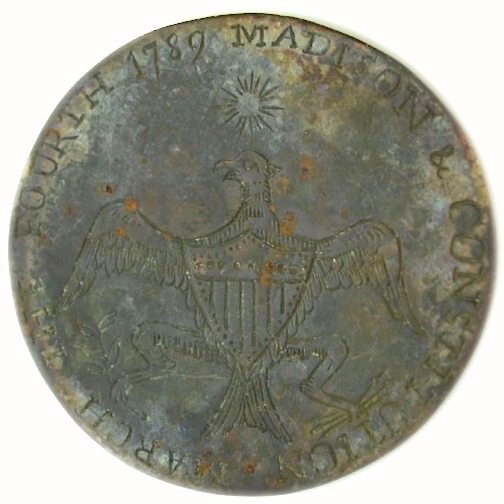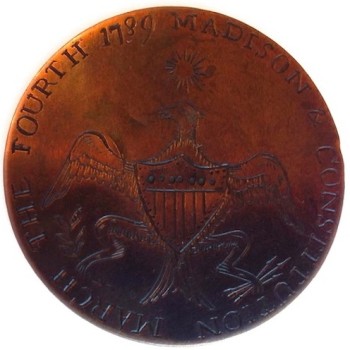 March The Fourth 1789, Madison & Constitution
March The Fourth 1789, Madison & Constitution
Concept Notes
by
Robert J. Silverstein
In the colonial era, it was common for Master Artisan engravers to take on young apprentices to learn the craft. This apprenticeship usually started at a young age, and lasted for about 10 years. It was the accepted responsibility of the Master Artisan to instruct and teach his apprentice the techniques he would need to become a Master Artisan himself. I believe that somewhere during the Federal period between 1789 and 1809, a Master’s apprentice was given the assignment of making a rendition of the popular George Washington inaugural or New Nation Tribute buttons. Sort of like an art class and everyone asked to draw a subject. The Master’s instruction was most likely to teach his apprentice the current techniques in engravings by using popular subject matter such as the celebratory inaugural buttons. This would be the most practical and current way for a master to have his apprentice practice the art of engraving with popular subject matter. I know for a fact from inspection that there is an “unknown series of GWI inaugural & NNT buttons” that were made by an apprentice (or apprentices) over a span of years that gives specific tribute to each of our first 4 Presidents. Unfortunately, without the owners permission i cannot display the photographs of these various artist rendition inaugural buttons on my website’s library for political button collectors to admire. (Maybe one day, real soon).
What i can conclude after studying all 7 types inaugural & new nation tribute buttons is that it appears as if one (or maybe two) apprentice artisans were practicing techniques in the art of engraving during the federal period from 1789 to 1809. What I have come to believe is that engraving was a secondary art for these apprentices. This conclusion stems from a combination of factors. First, is the quality of the artist depiction on the buttons. The buttons that are attributed to later date Presidents such as Adams-Jefferson lack a realized improvement skill that an apprentice engraver would have normally gained in his pursuit of becoming a Master Engraver. Meaning, this apprentice might have been mentored for an associated art like painting, ect.., and engraving was not his main artisan endeavor. Learning associated art skills would be normal in that era. Even Robert Scot Chief engraver of the United States Mint who I have positively identified as one of the several artisans who engraved the original 1789, George Washington inaugural buttons was apprenticed originally in London as a clock maker. Since, his father George Scot was the founder and Master Artisan of Cannongate Lodge in Scotland, this opened the door for him to learn the associated arts by other well known artisans. For people that don’t know Scotland’s Cannon gate Lodge, it was known in Europe as the premier Artisan hub for most of the well known European Artists. These artist were usually Royal bloodlines that came from other countries. Anyway, the point being is that in this era, it would be normal for an apprentice to be schooled in other various arts in-conjuntion to his specific field of study.
The next consideration is the thickness of the button’s planchet. As we move towards the 19th century, the later date inaugurals that were anniversary issues had thicker planchets. This would be consistent with other later date buttons that were marketed in the states for celebratory or military issue. Another supporting factor to the Federal period time line is the button’s dedication changed to the newly elected President who would be going into office. In the case of the John Adams inaugural, we have a salute to Washington in the legend, “March 4th 1789, Washington Once President Forever Countryman.” This means that Adams is President Elect, or just going into office. In this button’s depiction, the eagle is facing John Adam’s name which is inscribed in the button’s open field. Jefferson name (being the Vice President) was placed behind the eagle’s nape. These key aspects to the button help me give weight in dating the buttons properly to the 1797’s Federal period. Also, this button’s date, March the Fourth 1789, would be the 1st inaugural button to have the actual inauguration date. Lastly, the planchet’s thickness on this celebratory button is consistent with other later date Anniversary issue George Washington inaugural buttons. (The 3 known Madison specimens however would be assigned an earlier date of 1789, because of several of the button’s characteristics).
So, where did all of these unknown Presidential inaugural buttons come from, and how come there is no manufacturing records of their existence? Why is it there is no dug specimens? Why wouldn’t any political button collector know about these in 225 years? All good questions, and I would like to put forth my personal theory on this subject. As mentioned, I believe all of these buttons were made by a Master’s Apprentice that was most likely schooled in one of the associated Arts. As with all artists, he probably kept all of his creative art works together in his house or at school. This is common practice with all artist, even in today’s times. This artist’s creative works were probably kept by through time by his family members. Just being passed down through the generations. We have seen this with real GW buttons. Since these buttons were only considered a former family member renditions of the real thing, and not the real thing, the family probably never gave it a collector’s monetary value, or even a collectability weight in the Presidential political collector’s arena. Also, political buttons as a highly valued collectable isn’t what it is today. Anyway, at some point in time, the artist’s renditions were purchased by a button collector, or just someone who collects things from the Federal period. The button collection was then sold again (Maybe multiple times) as either its own entity, or part of a whole collection of Federal period memorabilia to the newest current owner. This individual has now decided to break apart this collection, and sell them in the market place for the first time. So, one should consider these as collectables on many fronts. Federal Period memorabilia, Authentic button tributes to Presidential founding fathers, and the realized works of an 18th century artisan.
If my website’s patrons are patient, I will get the owner’s permission sooner or later to display all of these beautiful Federal period tribute buttons which were dedicated to our Founding Father Presidents. The different button renditions that i have studied include specific tributes to George Washington, John Adams & Thomas Jefferson, James Madison, and NNT buttons to our New Federal Government with a depiction of the Great Seal of the United States. All the planchets are 34mm. to 36mm. which are large inaugural size buttons. After thoroughly studying my own Madison button, and 7 other button patterns, I have no doubt in my mind that these are authentic to the Federal time period of 1789 and can be as late as 1809. Since these buttons were not mass produced or sold in the U.S. market place for a President inauguration or Patriotic Anniversary, I do not consider these “Prototypes” for a final manufactured product for a celebratory event. I weigh them as Federal period buttons of a unique design idea that shows an Apprentice Artist’s creativity for an inaugural type button!
NNT 32-A THE 1789 MADISON & CONSTITUTION FINAL ARTIST RENDITION C
Color: An Array of Browns, Yellows, Greens, Grays, and Patches of Black.
Metal: Flat, 1-Piece, Stamped Design, Copper
Size: 33.86mm. Large Inaugural Size
Rarity: R-6
Variety Type: 5 Petal Olive Branch / 7 Stipple Shield / 47 Perimeter Shield Stipples / Misaligned Arrow Shafts / Narrow Open Beak / Slightly Crooked Letters / 19 Sun Rays, South Point / Triple Line Letters, Large 9 /
Present Condition: An Excavated Specimen, A Strong Planchet Condition, An Exceptional Impression Remains.
Obverse Button Analysis:
Reverse Button Analysis: This is flat a one-piece button with a soldered on loop shank. The shank is original, straight and intact. There is dirt & corrosion around the shank.
Library Records Has Limited Information on NNT 32 A-1:
History: No Recorded Sales Price: Yes
Current Button Owner and Location: ~ New York ~
The RJ. Silverstein Collection.
NNT 32-A THE 1789 MADISON & CONSTITUTION ARTIST RENDITION A
Color: An Array of Browns, Yellows, Greens, Grays, and shades of Black.
Metal: Flat, 1-Piece, Stamped Design, Copper
Size: 33.91mm. Large Inaugural Size
Rarity: R-6
Variety Type: 5 Petal Olive Branch / 8 Stipple Shield / 41 Perimeter Shield Stipples / Aligned Arrow Shafts / Wide Open Beak / Slightly Crooked Letters / 20 Sun Rays, North Point / Inconsistent Wing Feather Shape //
Present Condition: An Excavated Specimen, A Strong Planchet Condition, A Strong Impression Remains.
Obverse Button Analysis:
Reverse Button Analysis: This is flat a one-piece button with a soldered on loop shank. The shank is original, straight and intact.
Library Records Has Limited Information on NNT 32 A-2:
History: No Recorded Sales Price: No
Current Button Owner and Location: ~ Mid West ~
NNT 32-A THE 1789 MADISON & CONSTITUTION ARTIST RENDITION B
Color: A Coppery -Orange W/Brown Undertones.
Metal: Flat, 1-Piece, Stamped Design, Hand Detailed Afterward in Planchet, Copper.
Size: 34mm. Large Inaugural Size.
Rarity: R-6
Variety Type: Eagle’s Head Features Incorrect / Wings Lack Symmetry / Number Date Lacks Letter Conformity / 6 Petal Olive Branch / 19 Sun Rays, No dm Ring Around Corona / 7 Stipple Shield /
Present Condition: An Excavated Specimen, A Strong Planchet Condition, A Strong Impression Remains.
Obverse Button Analysis:
Reverse Button Analysis: This is flat a one-piece button with a soldered on loop shank. The shank is original, straight and intact.
Library Records Has Limited Information on NNT 32 A-3:
History: No Recorded Sales Price: No
Current Button Owner and Location: ~ Mid West ~




